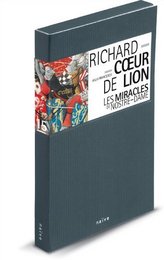| All Artists: De Coincy, Alla Francesca, De Lion Title: Les Miracles De Nostre-Dame Members Wishing: 2 Total Copies: 0 Label: Naive Original Release Date: 1/1/2009 Re-Release Date: 11/17/2009 Genre: Classical Styles: Historical Periods, Classical (c.1770-1830) Number of Discs: 2 SwapaCD Credits: 2 UPCs: 822186400111, 822186400111 |
Search - De Coincy, Alla Francesca, De Lion :: Les Miracles De Nostre-Dame
CD Details |
CD ReviewsYet another jingly and ethnic trouvère release Maddy Evil | London, UK | 07/05/2010 (2 out of 5 stars) "This 2-CD set is a reissue of two previous recordings made by Alla Francesca: Richard Coeur de Lion (Richard the Lionheart): Troubadours & Trouvères in the Courts of Eleanor of Aquitaine, Richard the Lionheart, Marie de Champagne & Geoffroy, Duke of Brittany - Alla Francesca, which focusses on music from the time of Richard the Lionheart (1157-99), and Gautier De Coincy: Les Miracles de Nostre-Dame, music from Gautier de Coincy's massive vernacular verse narrative (some 30,000 lines) in praise of the Virgin Mary, written between 1214 and 1233. For those unfamiliar with this ensemble, it consists of Emmanuel Bonnardot (voice, fiddle), Pierre Hamon (various flutes, bagpipes) and Brigitte Lesne (voice, harp), to which other musicians are also added (here the singers Raphaël Boulay [Lionheart programme] and Catherine Sergent [Coincy programme])
Without beating about the bush, these performances are both uninspiring, in spite of their evident merriment, and frequently dubious from an academic point of view, contrary to Alla Francesca's desperate claim that they "examine" the sources "in the light of work carried out by musicologists and themselves". Firstly, concerning the pieces in the Lionheart programme, modern-day specialists (such as Christopher Page, Elizabeth Aubrey, Margaret Switten etc...) are in agreement that in Troubadour and Trouvère song, both metrical singing and instrumental participation - normally on just one instrument at that - were actually limited to "low style" genres (such as the pastourelle), whereas "high style" genres (like the chanson) were generally sung with neither strict rhythms nor accompaniment (except sometimes to the fiddle or harp). It doesn't take long, then, to establish that this contrasts starkly with a large number of Alla Francesca's performances, such as Chastelain de Couci's chanson "Li nouviautz tanz" (here performed in decidedly "low style" fashion, in 6/8 meter to the accompaniment of double flute and percussion), Conon de Béthune's chanson "Bien me deüsse targier" (accompanied by 3 instruments) and Gaucelm Faidit's planh "Fortz chausa est" (2 singers in improvised polyphony), etc, etc, etc... Let's now turn to Coincy's "Miracles de Nostre-Dame". Contemporary documents such as "Dit de la panthère d'amor" (c.1300) describing performances of devotional music (similar to Coincy's "Entendez tuit ensemble") sometimes suggest large forces of voices and instruments - i.e. substantially more than Alla Francesca's set-up of four musicians - although the evident parallels in the "Miracles de Nostre-Dame" to Trouvère song in form, language, imagery and refrains, strongly suggest that similar performance expectations - i.e. one singer and one instrument - were the other norm. Additionally, whilst fiddles were clearly associated with the monophonic conductus (like "Ma viële", to which jingles are needlessly added here), the polyphonic conductus and motet repertoire was most often for voices alone (unlike the fussy orchestrations here of "S'amour dont sui espris" and "Hui matin a l'ajournee"). Yet perhaps the biggest clue to the "do-as-you-please", pick 'n' mix approach adopted here is the expansive list of instruments on offer, particularly wind and percussion. If the prize for the most unaesthetic instrument goes to the "Macedonian bagpipes" (whose decidedly flat 3rds and 4ths clearly do not correspond to medieval descriptions of temperament, Pythagorean or otherwise), the biggest irritation is easily the persistent presence of Indian-style "bamboo flutes". No modern-day exponent of these apparently "medieval" instruments has yet explained their connection to medieval Europe. So why has the Indian bansuri stolen the limelight...? Why not use a Korean taegum, an Uzbek nay, a Japanese shinobue or a Ugandan ludaya instead...? Unfortunately, it is extremely easy to find other recordings of this repertoire that are just as dodgy and just as unsatisfying as these. However, there are also some much better recordings that are worth checking out if this repertoire really interests you: 1. Two recordings by Gothic Voices: Music for the Lion-Hearted King and Spirits of England & France, vol. 2 2. The Harp Consort's release entitled Miracles of Notre-Dame which, in spite of a few rash decisions (from an academic perspective), is infinitely more aesthetic than Alla Francesca's version. " |

